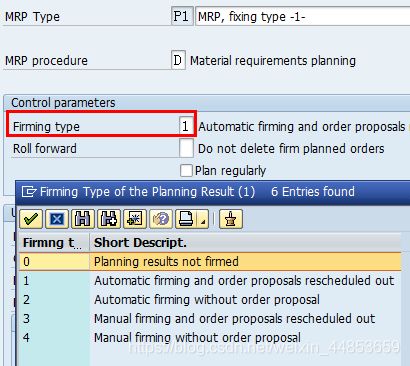MRP类型配置中的固定类型firm type设置详解
MRP类型配置中的固定类型firm type设置详解
作者:袁云飞(AlbertYuan)- 微信号yuanalbert
以下内容均为原创,希望对初学者有一些辅助作用,本人主要从事MM/QM/WM的相关工作,不专业处请多多指点,十足干货,码字不易,且行且珍惜,你们的关注就是我努力的动力,转载请引用出处,感激不尽;

有四个固定类型,主要就是用来固定获取建议的,而是否固定一般就是通过计划时间片段(也叫计划的时界)这个参数来约束的;
也就是说我们设置一个工作日表示的时间,作为计划时间片段,计划运行的日期作为开始时间,加上时间片段后的日期作为结束时间,这就存在4中固定获取建议的方法了。
For the planning run, the firming type determines how procurement proposals are firmed and scheduled within the planning time fence. There are the following firming types:
• 0
Procurement proposals are not firmed automatically. No firming takes place with this firming type.
• 1
Procurement proposals within the planning time fence are firmed automatically as soon as their date is at least one day before the end date of the planning time fence.
The date of new procurement proposals created in the planning time fence is moved to the end date of the planning time fence. As a result, these new procurement proposals are not firmed.
• 2
Procurement proposals within the planning time fence are firmed automatically as soon as their date is at least one day before the end date of the planning time fence.
No new procurement proposals are created automatically within the planning time fence; that is, the shortage situation is not adjusted within the planning time fence.
• 3
Procurement proposals within the planning time fence are not firmed automatically.
All procurement proposals required to cover the requirements are moved to the end of the planning time fence.
• 4
No procurement proposals are created automatically within the planning time fence; that is, the shortage situation is not adjusted within the planning time fence.
而计划时间片段这个值,可以在工厂参数里维护,也可以在MRP组里维护,也可以在物料主数据里维护;

![]()

我们可以看看官方关于计划时间片段的一些说明;
Planning Time Fence
Use
You can protect the master plan from any automatic changes to master schedule items in the near future by using a planning time fence.
During the planning run, the system makes no automatic changes to order proposals within the planning time fence (which is specifically determined for every master schedule item).
The system always dynamically calculates the end date of the planning time fence starting from the planning date.
Integration
You can use the planning time fence for materials planned in MRP, for master schedule items in master production scheduling and also for materials in long-term planning.
Prerequisites
You must maintain MRP types with firming types in Customizing for long-term planning or MRP. The firming type defines how the system firms order proposals and how it schedules them.
You must enter an MRP type with a firming type in the material master record for the planning time fence to have an effect.
Features
The system firms all planned orders that lie within the planning time fence. This means, the planning run can no longer make changes to firm planned orders in the long-term planning run.
Outside the planning time fence, the system creates order proposals based on the shortage quantity and the lot-sizing procedure as usual.
When these planned orders move into the planning time fence, they are firmed automatically depending on the setting of the firming type.
You can define the planning time fence either individually per material in the material master record or via the MRP group.
SAP 中MRP类型 P1,P2,P3,P4,PD的区别
由于MRP type设置中firm type的不同,所以MRP type产生的plan order的固定方式不同
p1 自动固定firm period之前的plan order,生成新的plan order排在firm period之后
p2 自动固定firm period之前的plan order,不生成新的plan order
p3 不固定firm period之前的plan order,生成新的plan order
p4 不固定firm period之前的plan order,不生成新的plan order
另外还有ND、PD!
ND是不使用MRP,如果 Material_ master 没有MRP TYPE,则应跳过MRP4个VIEW(MM01)!
PD 没有firm period的问题,重新生成新的plan order
M0 MPS,固定类型 -0-
M1 MPS,固定方式 -1-
M2 MPS,固定方式 -2-
M3 MPS,固定方式 -3-
M4 MPS,固定方式 -4-
ND 无计划
P1 MRP, 固定类型 -1-
P2 MRP, 固定类型 -2-
P3 MRP, 固定类型 -3-
P4 MRP, 固定类型 -4-
PD 物料需求计划
R1 分时段计划
R2 分时段计划无自动重订货点
RE 外部补充计划
RF 含动态目标库存的补充
RP 补充
RR 含动态目标库存的分时段补充
RS 周期性补充计划
V1 外部需求中的人工重订货点
V2 外部请求中的自动重订货点
VB 人工重订购点计划
VI 供应商管理库存
VM 自动重订货点计划
VS 季节的MRP
VV 基于预测的计划
X0 没有MRP,用BOM展开
一.V1.V2.VB…
对于使用再订购点MRP类型的物料,再订购点数量必须大于安全库存,使用再订购点订货可以设定只考虑再订购点(库存),不考虑独立需求或客户需求及SO引发的相关需求,库存低于再订购点运行MRP就会促发计划订单。
VB-人工重订购点,不考虑外部需求。
V1-含外部需求的人工再定货点,V2-含外部需求的自动再订货点。
考虑外部需求
外部需求可以设定为包含补货提前期以内的,或总体的外部需求,同时设定外部需求的种类
一般情況下,重订货点与批量结合使用,如批量设置成設置成补货到最大庫存水平。
二.MPS M0~M4
M0-计划结果未被确认的MPS的MRP类型,当需求日期不能满足生产周期时,系统将自动计划到能够满足生产周期之后。
M1-动确认和订货建议被重新计划MPS的MRP类型,也就是说这个MRP类型必须维护’规划时栅’字段,当需求日期在规划时栅日期以内的时侯,运行的MPS的结果计划订单自动计划到规划时栅之后,因为规划时栅的作用是确保规划时栅内原先的排程结果不改变。
M2-不含订货建议的自动确认MPS的MRP类型,就是新建的需求在规划时栅日期以内的不会产生计划订单,但是可以耗用确认过的生产订单。
M3-人工确认和订单建议被重新计划, 计划时栅以内的需求计划订单排到计划时栅以外。
M4-人工确定不含订单建议MPS的MRP类型,就是需求在计划时栅以内的需求运行MPS时不会产生计划订单,需要手动创建计划订单,只有计划时栅以外的需求产生计划订单,当计划订单由计划时栅外变成计划时栅內時……。
这个所谓的固定类型和计划时间片的应用作用在哪里呢,情况:
Demand time fence & planning time fence
物料的需求时界一般设为等于或略大于该物料的总装提前期(即物料本身的提前期),其意义在于提醒计划人员,在该期间内,因已下达订单,且订单已经在进行最后的总装,变更订单将带来巨大损失,不应该改变订单。
计划时界需大于等于需求时界,通常设置为等于或略大于物料的累计提前期,其意义于提醒计划人员,在这个时界和需求时界之间的计划已经确认,且一些采购或生产周期较长的物料采购、生产订单已经下达,计划的修改需受控。
Demand time fence & planning time fence 2
需求时界和计划时界为了说明修改主生产计划的限制条件、难易程度,以及付出的代价,从而谋求一个比较稳定的主生产计划,提出时界和时域的概念,向计划人员提供一个控制计划的手段。
在计划展望期内最近的计划期,称为第一个时域,其跨度等于或略大于最终产品的总装配提前期;稍后的计划期,称为第二时域,其跨度加上第一时域的跨度等于或略大于最终产品的累计提前期;第二个时域以后的计划期称为第三时域。
第一、二十余的分界线称为需求时界,他提醒计划人员,早于这个时界的计划已在进行最后的总装,不宜再做变动;
二、三时域的分界线称为 计划时界,它提醒计划人员在这个时界和需求时界之间的计划已经确认,不允许系统自动更改,必须由主计划员来控制;在计划时界以后的计划还没有经过确认,系统可以改动。
计划时界和需求时界是计划过程中的两个时间点,在不同的计划时间段里,计划的准确性是不同的。在近期,计划比较准确,可能是确定的销售订单;
但在较远计划时间段里,计划可能包含了销售订单和预测,或者仅仅是预测。因此,在MRP运算时,我们用需求时界和计划时界来区分不同的计划阶段,在需求时界内取订单作为需求的来源,在需求时界和计划时界之间,取订单和预测的较大值,在计划时界以外,取预测的值作为需求。
以上为本章全部内容,希望对小伙伴们有所帮助;